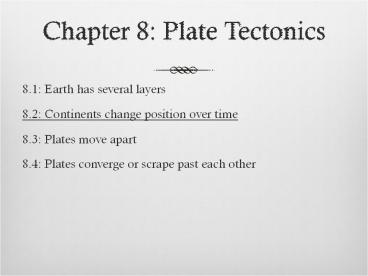Chapter 8: Plate Tectonics - PowerPoint PPT Presentation
Title:
Chapter 8: Plate Tectonics
Description:
Chapter 8: Plate Tectonics 8.1: Earth has several layers 8.2: Continents change position over time 8.3: Plates move apart 8.4: Plates converge or scrape past each other – PowerPoint PPT presentation
Number of Views:121
Avg rating:3.0/5.0
Title: Chapter 8: Plate Tectonics
1
Chapter 8 Plate Tectonics
- 8.1 Earth has several layers
- 8.2 Continents change position over time
- 8.3 Plates move apart
- 8.4 Plates converge or scrape past each other
2
8.2 Continents change position over time
- Before, you learned
- Earths main layers are the core, mantle, and
crust - The lithosphere and asthenosphere are the topmost
layers of Earth - The lithosphere is made up of tectonic plates
- Now, you will learn
- How the continental drift hypothesis was
developed - About evidence for plate movement from the sea
floor - How scientists devloped the theory of plate
tectonics
3
Core, Mantle, Crust
Litho stone or rock Asthenes weak
- Lithosphere crust and very top of mantle
solid, most rigid layer - Asthenosphere hotter, softer rock in the upper
mantle (just below the lithosphere) can flow
like hot tar
Less dense materials rise
Denser materials sink
4
Continents join together and split apart
- As far back as the 1500s, map makers noticed the
western coast of Africa and the eastern coast of
South America seemed to fit together - 1912, German scientist Alfred Wegener proposed
the hypothesis continental drift
5
Evidence for Continental Drift
- Fossils
- Fossils of an ancient (270 million years ago)
reptile Mesosaurus were found in South America
AND western Africa, but no where else in the
world - Explanation the continents were once joined
- Climate
- Greenland today is mostly covered in ice, yet
tropical plant fossils are found there - South Africa is warm, but rocks were deeply
scratched by ice sheets - Geology
- Kinds of rocks that make up the continents those
found in Brazil match those in western Africa - Limestone layers in the Appalachian Mountains
(NA) exactly like Scotlands Highlands
6
Pangaea and Continental Drift
- Huge supercontinent over 200 million years ago
- Pangaea, all lands
- Centered over where Africa lies today
- But how?
7
The theory of plate tectonics explains how plates
and their continents move
- Mid-1900s scientists proved tectonic plates
move - Evidence from the sea floor
- Huge underwater mountain ranges mid-ocean ridges
circling earth like baseball seams
8
The theory of plate tectonics explains how plates
and their continents move
- Evidence from the Sea Floor
- Sea-Floor Spreading the ridges form along cracks
in the crust, melted rock rises through these
cracks, cools, and forms new oceanic crust
9
The theory of plate tectonics explains how plates
and their continents move
- Evidence from the sea floor
- Age of the sea floor youngest rocks cloest to
the ridge, oldest rocks farther away - Oldest ocean floor is young 160 to 180 my old
continental crust much older 4 billion yrs - Ocean Trenches
- Sea floor spreads, then dense oceanic crust sinks
into the asthenosphere (upper mantle) into huge
trenches (like deep canyons) - Old crust destroyed as new crust forms Earth
remains the same size
10
Causes of Plate Movement
- Tectonic plates rest on the asthenosphere layer
of soft, hot rock - Moves by convection heat transfer by the
movement of a material - Hot soft rock rises, cools, and sinks, then is
heated and rises again convection current slow
few cm/yr - Slab pull gravity pulls the edge of a cool,
dense plate into the asthenosphere the entire
plate is dragged along - Ridge push material from a mid-ocean ridge
slides downhill from the ridge
11
(No Transcript)
12
Putting the Theory Together
- Theory of plate tectonics the Earths
lithosphere is made up of huge plates that move
over the surface of the Earth - One plate could not shift without affecting the
others nearby - Plates can move apart, push together, or scrape
past each other - Most major earthquakes, volcanoes, and mountain
ranges appear where tectonic plates meet
13
(No Transcript)
14
- List of animations!
- http//www.wwnorton.com/college/geo/egeo/animation
s/ch2.htm































